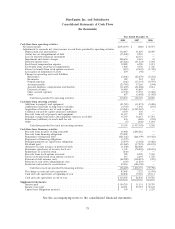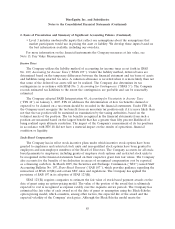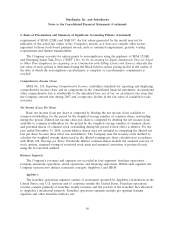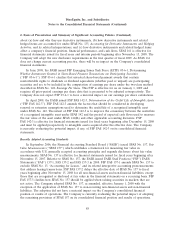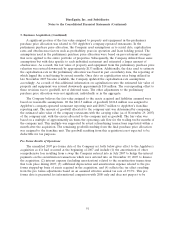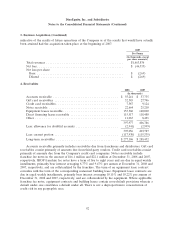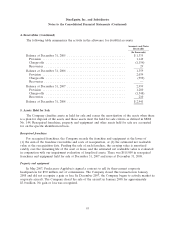IHOP 2008 Annual Report Download - page 98
Download and view the complete annual report
Please find page 98 of the 2008 IHOP annual report below. You can navigate through the pages in the report by either clicking on the pages listed below, or by using the keyword search tool below to find specific information within the annual report.DineEquity, Inc. and Subsidiaries
Notes to the Consolidated Financial Statements (Continued)
2. Basis of Presentation and Summary of Significant Accounting Policies (Continued)
Asset Retirement Obligations
The Company currently has certain leases which may require it to return the property to the
landlord in its original condition. The Company records expenses for these leases in its consolidated
financial statements as company restaurant expenses. At December 31, 2008 and 2007, the liability
recorded for asset retirement obligations was $0.3 million and $0.6 million, respectively.
Derivative Financial Instruments
The Company accounts for derivative instruments and hedging activities in accordance with SFAS
No. 133, Accounting for Derivative Instruments and Hedging Activities (‘‘SFAS 133’’). All derivatives are
recognized on the balance sheet at their fair value. On the date that the Company enters into a
derivative contract, management formally documents all relationships between hedging instruments and
hedged items, as well as risk management objectives and strategies for undertaking various hedge
transactions.
Changes in the fair value of a derivative that is highly effective and that is designated and qualifies
as a cash flow hedge (a ‘‘swap’’), to the extent that the hedge is effective, are recorded in accumulated
other comprehensive income, until earnings are affected by the variability of cash flows of the hedged
transaction. The Company measures effectiveness of the swap at each quarter end, using the
hypothetical derivative method. Under this method, hedge effectiveness is measured based on a
comparison of the change in fair value of the actual swap designated as the hedging instrument and the
change in fair value of the hypothetical swap which would have the terms that identically match the
critical terms of the hedged cash flows from the anticipated debt issuance. The amount of
ineffectiveness, if any, recorded in earnings would be equal to the excess of the cumulative change in
the fair value of the swap over the cumulative change in the fair value of the plain vanilla swap lock, as
defined in the accounting literature. Once a swap is settled, the effective portion is amortized over the
estimated life of the hedged item.
The Company utilizes derivative financial instruments to manage its exposure to interest rate risks.
The Company does not enter into derivative financial instruments for trading purposes.
Fair Value Measurements
Effective January 1, 2008, the Company determines the fair market values of its financial assets
and liabilities, as well as non-financial assets and liabilities that are recognized or disclosed at fair value
on a recurring basis, based on the fair value hierarchy established in SFAS No. 157, Fair Value
Measurements (‘‘SFAS No. 157’’). We measure our financial assets and liabilities using inputs from the
following three levels of the fair value hierarchy. The three levels are as follows:
• Level 1 inputs are unadjusted quoted prices in active markets for identical assets or liabilities
that we have the ability to access at the measurement date.
• Level 2 inputs include quoted prices for similar assets and liabilities in active markets, quoted
prices for identical or similar assets or liabilities in markets that are not active, inputs other than
quoted prices that are observable for the asset or liability (i.e., interest rates, yield curves, etc.),
and inputs that are derived principally from or corroborated by observable market data by
correlation or other means (market corroborated inputs).
84



